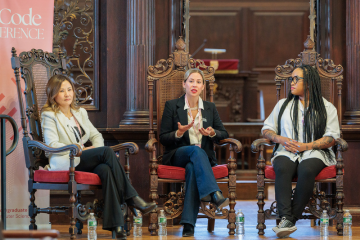 As shifts in public health are leading more professionals to dust off their resumes, recruiters are sharing their insights for job-searching success.
As shifts in public health are leading more professionals to dust off their resumes, recruiters are sharing their insights for job-searching success.
In a recent panel hosted by the de Beaumont Foundation and the American Public Health Association, program officer Maddie Kapur moderated a conversation with Leigh Warren, senior talent acquisition manager at Fleet Feet, and Brooke Mootry, CEO and lead recruiter for The Public Health Network, where they shared their tips for making the first cut in the job search process. Here’s their advice for standing out in a sea of applicants.
Refine Your Resume
A hiring manager may have just a few seconds to skim your resume. Keep it simple and streamlined so they can quickly recognize your strengths as an applicant.
- Make your resume easier to read by breaking up chunks of text with bullet points.
- Quantify your successes whenever possible. Don’t just state that you led a program; include examples of impact with numbers to support your accomplishments. Spell out how your efforts led to specific results.
- Remember that a resume isn’t a one-size-fits-all document. Tailor your resume to the organization you’re applying to, detailing skills, experiences, and accomplishments relevant to the role you’re seeking.
- Skip the fluff. You don’t need fancy templates or graphics that take up space and distract from the content. A well-written resume neatly formatted in a Word document or PDF speaks for itself.
- Before you submit your resume, proofread, proofread, proofread. Check for typos and grammatical errors, and make sure you’re addressing the correct hiring manager and organization.
Consider a Cover Letter
Not every organization will require a cover letter as part of the application, but there’s no harm in providing a complement to your resume. A cover letter is particularly helpful for adding context when applying for a role outside of one’s job history.
Without repeating all the bullet points in your resume, use your cover letter to briefly introduce yourself and explain why you’re a strong fit for the role. Your cover letter can also be a space to further highlight experience that’s especially relevant to the position you’re seeking.
Leverage LinkedIn to the Fullest
If you aren’t already using LinkedIn, make your profile now. “LinkedIn is going to be gold when it comes to expanding your network, your reach, and your visibility,” Mootry says.
- Fill out your profile completely to create a full picture of your job history. Include titles, tenures, and detailed descriptions of your job history. Don’t forget a clear headshot.
- Let people know that you’re actively job searching with LinkedIn’s “Open to Work” feature, which places a banner over your profile photo. You can also adjust the settings to keep your job-finding status private except to recruiters.
- Recruiters pay attention to your activity on LinkedIn. Be mindful of the content you post and the companies you follow (and of course, follow the companies you’re interested in).
- Update your notification settings so you never miss a message from a recruiter. If you take too long to respond, you may lose your chance at a job opportunity.
- LinkedIn is also a great tool for networking. Engage with other professionals on the platform even when you’re not actively seeking a new job.
Prepare for a Successful Screening
A screening interview with a recruiter is your chance to make a strong impression. “Instead of seeing the screening process as an impediment to the hiring process, see it as a partnership,” Mootry says. “I am your biggest cheerleader. I think that you may be an eligible candidate for the position, and I want you to work with me in this process.”
- Be prepared to answer specific questions about the contributions you’ve made to past roles and how you can add value to the organization you’re pursuing.
- Do your homework to get familiar with the company, showing that you care about being part of the larger organization, not just the role.
- Follow up with a note to your recruiter thanking them for their time and restating your interest in the position.
Know the Nuances Across Sectors
Depending on the sector you’re exploring, the application process will have certain differences to keep in mind.
Whereas resumes tailored for federal government positions are lengthier and follow a rigid structure, those for local government jobs are shorter and follow system formatting requirements. A resume tailored for a nonprofit job will focus on impact and purpose, while a resume for a private sector job should be tailored for applicant tracking software. See the table below for more details on these application differences across sectors.
| Sector/Application Component | Federal Government | Local Government | Nonprofit | Private Sector |
| Resumes | Lengthy and detailed; strict structure; showcase how you meet specialized experience | Short; use keywords; follow system format requirements | Professional; focus on impact and purpose | Concise; tailored for Applicant Tracking Systems (ATS); impact and results oriented; avoid fluff |
| Cover Letters | Optional; effective in showcasing specialized experience | Professional; tailored; not rigid | Opportunity to show your passion for the mission | Shows why you are the right fit and how you will bring value |
| Helpful for networking | Helpful for network and visibility | Often reviewed; helps to elevate connection/fit | Crucial in validating applications | |
| Screening Interviews | Highly structured; focused on knowledge, skills, and abilities (KSA) | Interview panel; scoring process | Conversational; behavioral and values-based questions | Fast paced; focused on fit and skills alignment |
But no matter if you’re moving from the public to the private sector or vice versa, remember that all organizations lead with their values, and you need to position yourself to fit within their framework.
“You have to show that you care about what we care about, that the culture fit is there,” Warren says.
Watch the full recording of the webinar, “Making the First Cut: Tips from Public Health Recruiters.”




